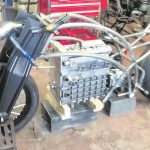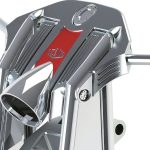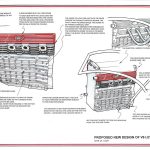It was also modular in its design meaning it could be cut down in size and could even be converted to run as a two-stroke, or a diesel. But the car project didn’t come to fruition, and the engine lay dormant for a decade. Now, two of the UK’s most innovative vehicle designers and engineers have put the engine in a motorcycle, resurrecting Levis in the process. The V6 Café Racer is an all-British motorcycle like no other that’s come before.
Potted history
The Levis name (Le-Viss not Lee-Vize, like the jeans) has a long history dating right back to 1911, when the firm made some of the best two-stroke motorcycles in existence. They were so good in fact, they won the Lightweight 250 class at the TT in 1920, and again in 1922. They then turned their hand to four strokes in the 1930s but paused production at the outbreak of WWII and never fully resumed. The last bike rolled off the production line in 1946 and they were all but forgotten. Until now.
Earlier this year Phil Bevan, an automotive designer, purchased the Levis name alongside the rights to the Connaught V10 engine. He brought in Steve Kirk as Head of Design and they put their heads together.
“I realised we had a two-litre V10 engine that’s only 13 inches across the cylinder head,” says Bevan. “So I said ‘let’s make a motorbike’.”
Having initially penned a V10 cruiser, the idea then evolved, and the first bike from the reinvigorated brand will be a V6 Café Racer. Its modular construction allows the configuration to be easily changed to create a V10, V8, V6, V4 or V-twin – with an incredibly narrow 22-degree V-angle, which enables single block construction. Plates in the block can be swapped to turn it from four-stroke to a wet-sump two-stroke, or even to a two-stroke diesel. The block can be altered along with the pistons and con-rods, to give different strokes to adjust the character of the power delivery, too.
In standard trim the V6 produces 130bhp and 140ftlb of torque, which Bevan says is “lively to say the least”, but the sky really is the limit. It’s not just the engine that’s a bit special either.
Frame game
Holding the whole thing together is a stainless-steel frame made at the Levis factory in the North East (the finished bikes will be assembled on the Isle of Man). They also make the Hossack-style front-end themselves out of billet aluminium, along with the wheels, gearbox and swingarm. Levis are so detail-obsessed that they make almost the entire bike in-house. This includes the ECU, ABS and traction control systems , using experience gained from building supercars. Each of the six header pipes has its own tiny catalytic converter in it, right next to the head, so there’s no ugly, heavy collector box – just six slim pipes.
The real deal
Levis are in the advanced prototyping stage with the V6 undergoing all the necessary testing to enable production in 2018 – including full Euro4 homologation.
At £52,000, it’s not cheap, but against the landscape of other exotica, like the £100,000 Lotus C-01, it suddenly doesn’t seem so expensive.
There will be an initial batch of six bikes, with the aim to increase production to 52 units in year two, while there’s also opportunity to expand the range with different styles and engine configurations. There’s even talk of the brand returning to the TT for the centenary of their 1920 victory. The V6 Café Racer will be launched early next year, but orders are being taken now – see levismotorcyclecompany.com
Highlights
- 1200cc V6 engine
- 130bhp & 140ftlb
- Stainless steel chassis
- Hossack style front-end
- Price £52,000
Styled to suit you
Although called the Café Racer, the shape of the bike is modular, so if you want a flat-track style seat unit you can specify one. There’s scope for an entire range of styles.
Pipes and slip-ins
The high-level pipes are inspired by the exhausts fitted to the original Levis race bikes from the 1920s, and include in-header catalytic converters.
Rolling stock
The Café Racer will boast shaft drive and a single sided swingarm. Mated to it is an 18in billet aluminium rear wheel wearing a fat 200-section rear tyre.
Smooth runnings
Due to the 22-degree V-angle and firing order, the 1200cc V6 engine is so smooth that it has no need for a cumberstome counterbalance shaft.







